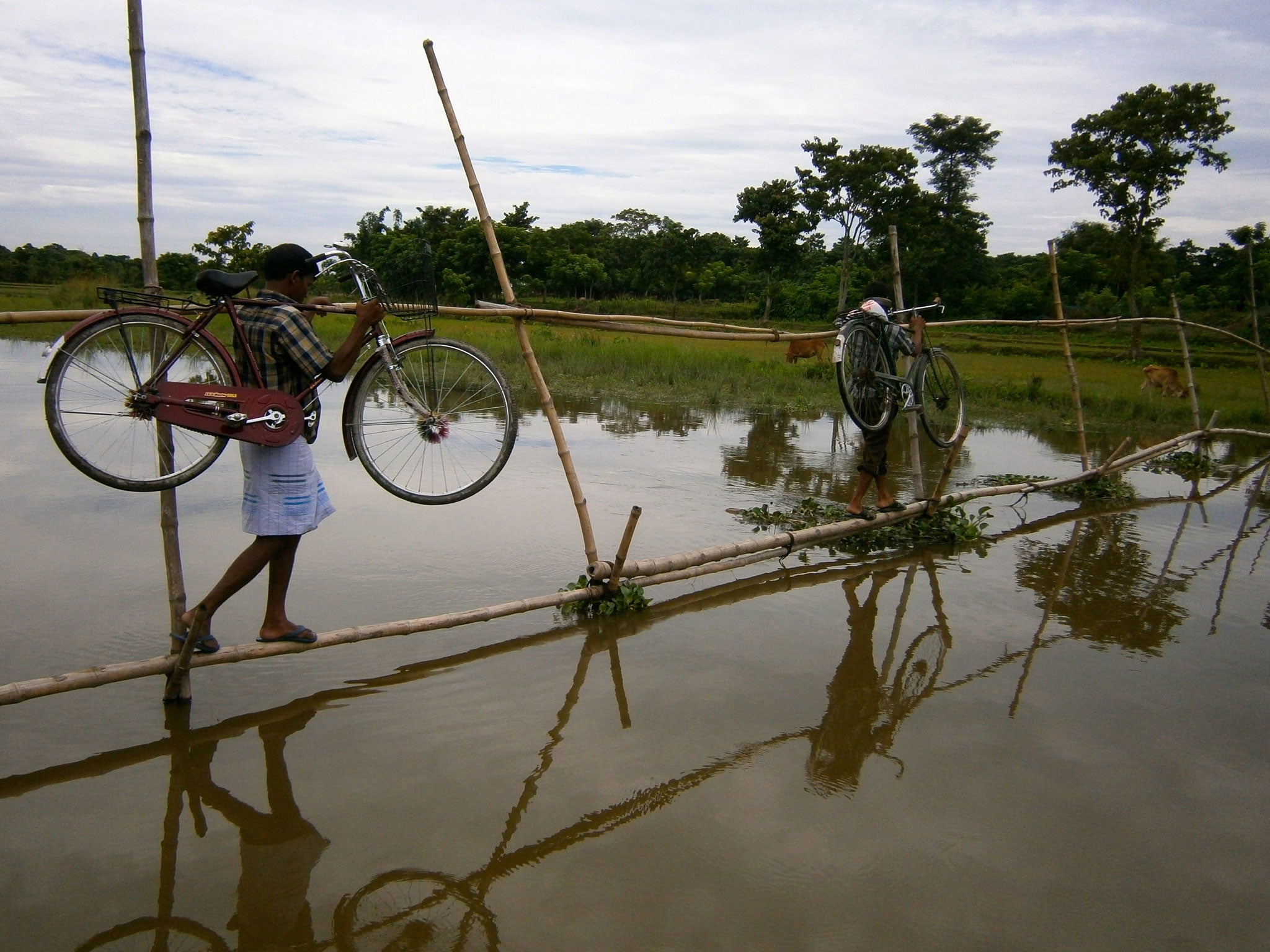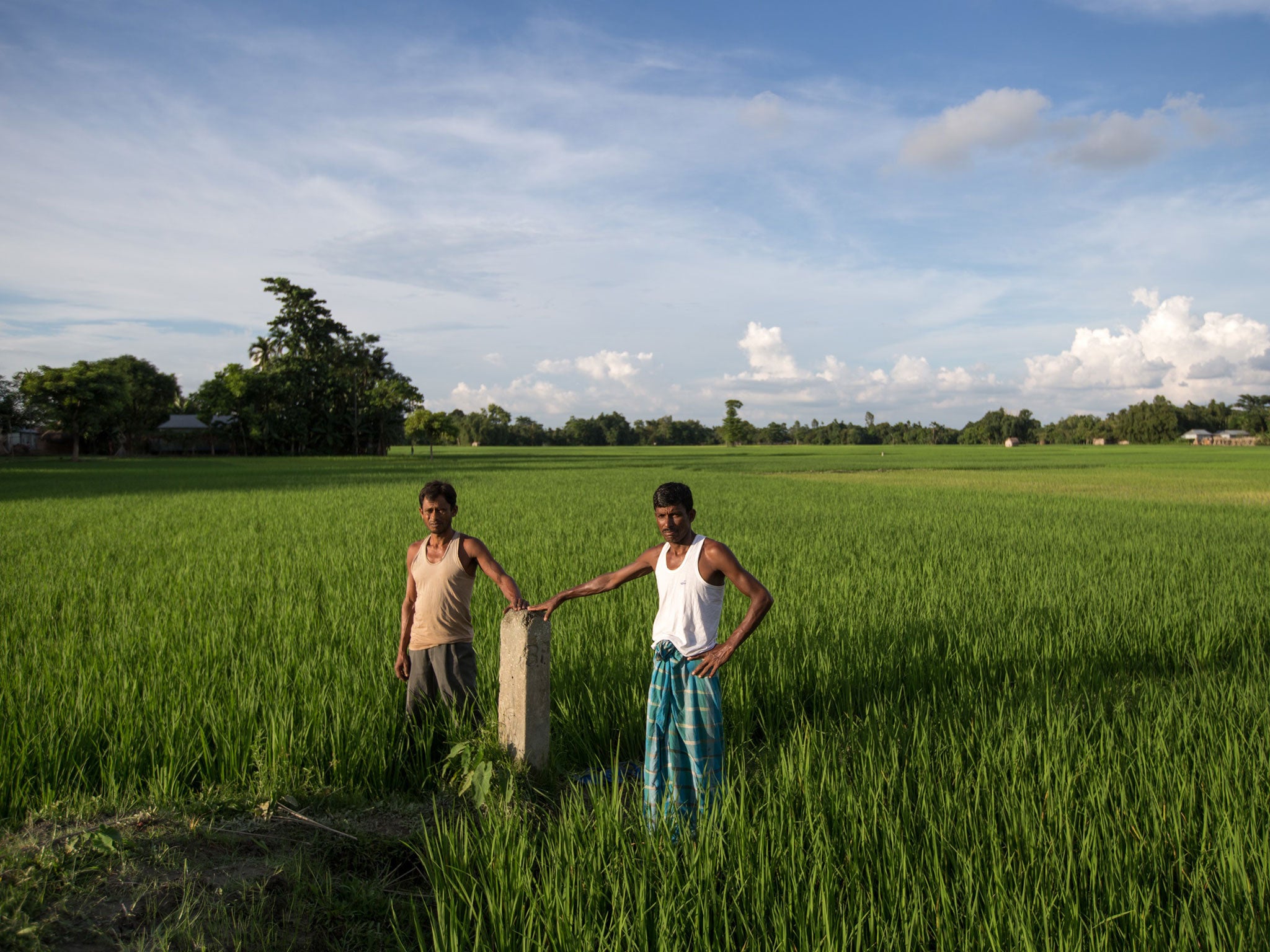Life inside no-man's-land: Welcome to Poaturkuthi - one of 70 Bangladeshi enclaves inside India
It might not look much, but a small ramshackle bridge makes all the difference to the lives of the people who live and work either side of it

Your support helps us to tell the story
From reproductive rights to climate change to Big Tech, The Independent is on the ground when the story is developing. Whether it's investigating the financials of Elon Musk's pro-Trump PAC or producing our latest documentary, 'The A Word', which shines a light on the American women fighting for reproductive rights, we know how important it is to parse out the facts from the messaging.
At such a critical moment in US history, we need reporters on the ground. Your donation allows us to keep sending journalists to speak to both sides of the story.
The Independent is trusted by Americans across the entire political spectrum. And unlike many other quality news outlets, we choose not to lock Americans out of our reporting and analysis with paywalls. We believe quality journalism should be available to everyone, paid for by those who can afford it.
Your support makes all the difference.By no measure would Gopal Chandra Barman describe himself as man of means. He works back-breaking days beneath a blistering sun to grow rice and vegetables to sell in the market.
But unlike his friends who farm the adjoining fields, when he goes home in the evening there is sometimes electricity, he can send his two children to the local school and he in possession of an identification card that allows him to vote.
There is no border fence next to Mr Barman's home, no immigration officers on duty. The only suggestion his home sits on any sort of boundary is a small cement pillar, half-blanketed in lichen, which was erected by the British in 1932.
But while the Indian government recognises the 50-year-old farmer as one of its citizens, it considers his neighbours - whose village sits in a parcel of land surrounded by Indian territory - to be living in Bangladesh. As result, they have no rights to the services that he takes for granted.
“It's a very bad feeling that I can cast my vote but my neighbours are not able to,” he said. “If they had voting rights, it would be much better for them.”
The 3,000 residents of Poaturkuthi, as the pocket of land is known, are among an estimated 51,000 people on both sides of the India and Bangladesh border living in no man's land. Largely forgotten creations of the machinations of history, 111 Indian “enclaves” exist inside Bangladesh while there are around 70 Bangladeshi enclaves, including Poaturkuthi, inside India.
Local tradition has it that the parcels of land were swapped as spoils following a series of chess games played between two local princes three centuries ago. (In reality they were most likely the spoils of war.)
But while the situation could under different circumstances seem quixotic or quaint, for the 51,000 enclave dwellers the circumstances are nothing less then perilous. Refused services by the country by which they are surrounded, they are also ignored by the nation to which they technically belong.
The consequences are manifold. Residents of the enclaves cannot legally travel or work outside their parcels of land, there are no schools, no hospitals, no running water or power. If they do leave to find labour, as thousands of them do, they require fake identification papers. In the past, enclave dwellers have been shot and killed while the farmers never received the correct rate for their crops as they were obliged to sell through a middle-man.
Beyond that, there are the deeper issue of identity. What should the people who farm these quiet rice fields call themselves? To whom should they show allegiance. To which nation should they offer fealty.
“Since 1947 when India became independent, we have had the house, we have had the land to cultivate and the tracks to walk, but we are detached from the society,” said Mansoor Ali Miah, 69, one of the community leaders. “The biggest problem is about identification. If we had a national identification card then we would get all the other things.”
Over the years, the enclave residents have discovered ways to work around India's sometimes elastic regulations: forged identity cards using names “borrowed” from families living in the “mainland” allow children to be signed on at schools, or fathers to work. Fake identity cards are similarly used to slip into government hospitals.
But it is not easy. “I went to school locally and borrowed an Indian name,” said Ersajul Miah, 23, who shares a name with the village elder and is one of the few residents of Poaturkuthi who has graduated from college. “Sometimes the teachers would say to me that I am from the enclaves and should not [be there]. They would say I should do agricultural work.”
There is also a problem of finding sufficient wives, as few outsiders want to move here. Most marriages take place inside the enclave, but the residents are aware of the danger of a reduced gene pool.
“Before getting married [two years ago] I knew nothing about the enclaves,” said Mansoor Ali Miah's daughter-in-law, Rashina Devi, who comes from a village 30 miles away and who complained about the lack of sanitation and services. “If I had known, I would not have agreed to get married to someone inside the enclave.”
The network of enclaves is vastly complicated, both historically and geographically. Inside many of the parcels of land there are smaller “counter enclaves” - for instance, a parcel of Indian land inside a Bangladeshi enclave inside of India.
In Bangladesh, at a place called Dahala Khagrabari, there is even a “counter counter enclave”: the 7,000 square metres of Indian territory is encircled by the Bangladeshi village of Upanchowki Bhajni which is in turn contained with the Indian village of Balapara Khagrabari which is itself surrounded by Bangladesh proper.

What the residents on both side of the border share is the sense of detachment. From Poaturkuthi, a piece of Bangladesh inside India, The Independent called a Bangladeshi number - dialling code +88 - to speak to someone living in a piece of India inside Bangladesh.
“The main problem relates to citizenship,” said Moti Zar Rehman, a resident of the Garati enclave in Bangladesh, his voice crackling on the phone's speaker, switched on to allow the people in Poaturkuthi to listen to the conversation. They all nodded in agreement.
And as for a solution? “The only solution is the implementation of the 1974 agreement that was reached by Indira Gandhi and Sheikh Mujibur Rahman,” said Mr Rehman. “According to that treaty, we should be Bangladeshis and those Bangladeshi enclaves should become part of India.”
Indeed, finding a solution to the situation seems reasonably simple - there should be a simple land swap. And from time to time, the politicians on both side of the border appear close to reaching a deal.
But each time the issue gets mired in local politics. Last week, the efforts of India's ruling Congress party to pass a land deal regarding the border, was squashed by the country's main opposition. The Bharatiya Janata Party claims a swap would “give” 10,000 acres of land to Bangladesh.
Diptiman Sengupta, an activist who heads the so-called enclave exchange committee, says he believes there is no political will. As a result, the people of the enclaves were being refused their right to a “motherland”.
“[The politicians] don't want to resolve the issue,” he said. “If they wanted to, the government could arrange something. It could happen at any time.”
Udayan Guha is a regional politician with the All India Forward Bloc, a left-wing party and whose constituency contains several enclaves.
He said the chief minister of the state of West Bengal, Mamata Banerjee, was opposed to a land swap because she feared of being accused by her opponents of “further dividing Bengal” - a reference to the partition of Bengal in 1947, with half becoming East Pakistan and subsequently Bangladesh.
“They don't know anything about the problems of the people of the enclave,' he sighed, seated in is office in the town of Dinhata. ”They don't have any experience of what it is like for these people.“
Border disorder: A history of the enclaves
Legend has it that the enclaves were created when two chess-playing royals gambled away villages from their kingdoms.
But Brendan Whyte, a historian at the National Library of Australia who has studied the enclaves extensively, is among those who say their existence has its roots in 18th-century fighting between the kingdom of Cooch Behar and the Mughal Empire.
He says that while an agreement in 1713 laid out the boundaries, some warlords in Mughal territory remained loyal to Cooch Behar and vice versa, leading to the enclaves.
Join our commenting forum
Join thought-provoking conversations, follow other Independent readers and see their replies
Comments